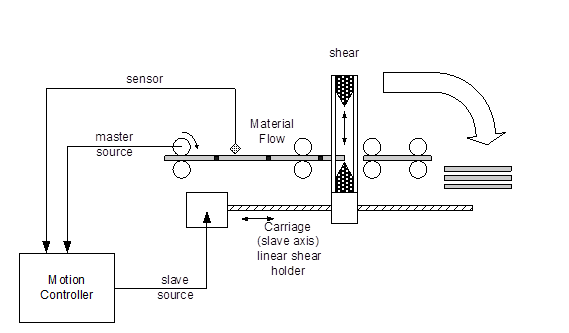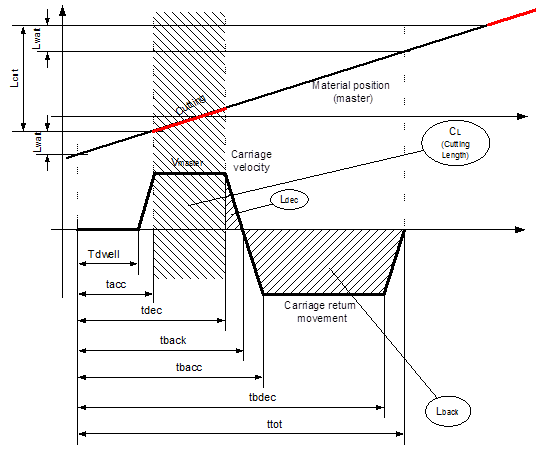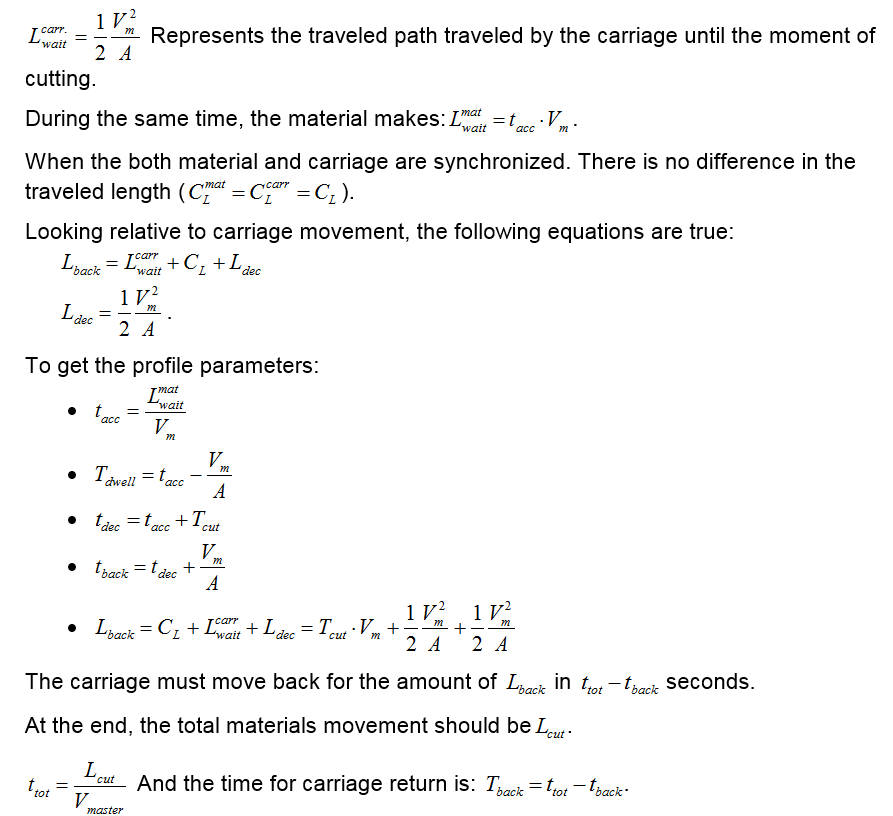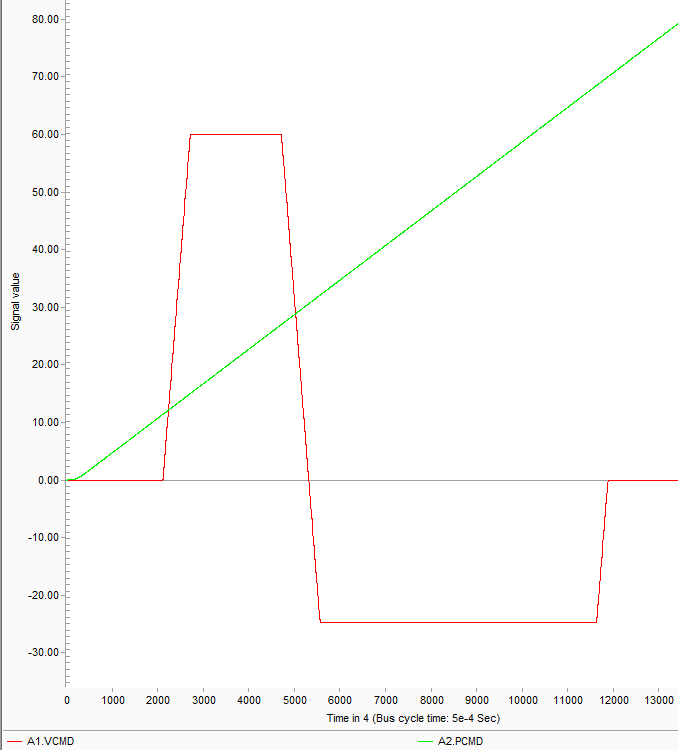Difference between revisions of "Flying Shear Application"
(→Motion profile) |
|||
| Line 1: | Line 1: | ||
= Introduction = | = Introduction = | ||
The task of a flying shear application is to cut a constantly moving material to a predefined length. Unlike the punch-cutting, the cutting is done in motion. In flying shear application, the motion task must remain synchronized the master and slave axis for a certain period of time and then go back to the initial position as fast as possible to be ready for the next cut. An optional sensor for length correction can be added. Although this is presented as a cutting application, the example can be used for other applications, such as applying labels or printing markings on the product. The application sets an output when the synchronization point is reached. This output can start the cutting mechanism but could start any other printing or labeling device. | The task of a flying shear application is to cut a constantly moving material to a predefined length. Unlike the punch-cutting, the cutting is done in motion. In flying shear application, the motion task must remain synchronized the master and slave axis for a certain period of time and then go back to the initial position as fast as possible to be ready for the next cut. An optional sensor for length correction can be added. Although this is presented as a cutting application, the example can be used for other applications, such as applying labels or printing markings on the product. The application sets an output when the synchronization point is reached. This output can start the cutting mechanism but could start any other printing or labeling device. | ||
| − | = | + | =Application Diagram = |
[[File:flyshr1.png]] | [[File:flyshr1.png]] | ||
| Line 194: | Line 194: | ||
</syntaxhighlight> | </syntaxhighlight> | ||
| + | |||
| + | = Output = | ||
| + | |||
| + | [[File:flyshr4.png]] | ||
Revision as of 12:20, 26 April 2017
Introduction
The task of a flying shear application is to cut a constantly moving material to a predefined length. Unlike the punch-cutting, the cutting is done in motion. In flying shear application, the motion task must remain synchronized the master and slave axis for a certain period of time and then go back to the initial position as fast as possible to be ready for the next cut. An optional sensor for length correction can be added. Although this is presented as a cutting application, the example can be used for other applications, such as applying labels or printing markings on the product. The application sets an output when the synchronization point is reached. This output can start the cutting mechanism but could start any other printing or labeling device.
Application Diagram
The approximate motion profile for a flying shear application looks like:
Motion profile
The motion is divided into three phases. The first phase includes the carriage dwell time. The carriage acceleration to the synchronization point is the phase where the carriage should be synchronized to a cut length of the master axis. The second phase or cutting is determined by the time needed for the cutting process to be completed. This phase is determined by cut time or the passed path of the material. The third and last phase is the return of the carriage to its home position. We assume that material flow velocity is constant and known: Vm. Further, we assume that both acceleration and deceleration values are the same. To get the cam profile parameters, use the following equations:
Here, known are L, T and A. The requested are profiler parameters tacc, tdec,v. Using the above equations, the code for the flying shear application is below (using the VTProfile and ProfileLTA routines from the Cut To Length example):
Program
common shared c1 as cam
dim shared toolong as error "The given cut length is too long for the given slave accel."
dim shared toofast as error "Slave axis can not move that fast"
dim shared tooshortw as error "Waiting period too short"
' Shared profile parameters:..............................................
dim shared lprof as double ' total legth
dim shared aprof as double ' acceleration used
dim shared vprof as double ' cruise velocity
dim shared t_acc_prof as double ' acceleration duration
dim shared t_dec_prof as double ' end of cruise phase
dim shared t_tot_prof as double ' total velocity trapeze duration
'.........................................................................
program
dim i as long
' Process data
dim Vmaster as double
dim CutLength as double
dim CutTime as double
dim DwellTime as double
dim BackLength as double
dim WaitLengthMaster as double
dim WaitLengthSlave as double
dim DecLength as double
dim CutPath as double
' Cam profile parameters
dim t_acc as double
dim t_dec as double
dim t_back as double
dim t_tot as double
dim vback as double
' Variables used in cam computation
dim t as double
dim dt as double
WaitLengthMaster = 15 ' Length in mm that is passed before the carriage is synchronized
Vmaster = 60 ' mm/sec - velocity of the material
CutLength = 70 ' mm of the master material feed
CutTime = 0.2 ' Time 200 ms needed for the cut
with A1 'A1 = Carriage (Slave)
Attach
Slave=0
FirstCam = none
CreateCamData 1000 c1 ' Creating 1000 points in the cam
CutPath = Vmaster*CutTime ' Path traveled during cutting process
t_acc = WaitLengthMaster/Vmaster ' end of acceleration
DwellTime = t_acc - Vmaster/acc ' dwell duration
if DwellTime < 0 then
throw tooshortw
end if
t_dec = t_acc + CutTime ' Time to start deceleration.
t_back = t_dec + Vmaster/acc ' Time to starts carriage return
t_tot = CutLength/Vmaster ' Total time of the movement is
WaitLengthSlave = 0.5*Vmaster^2/acc ' Path passed by slave during waiting
DecLength = 0.5*Vmaster^2/acc ' Path passed by slave during deceleration
BackLength = CutPath + WaitLengthSlave + DecLength ' Total movement length
' Setting for the first trapeze (forward carriage motion)
lprof = CutPath + WaitLengthSlave + DecLength
aprof = acc
vprof = Vmaster
t_acc_prof = t_acc - DwellTime
t_dec_prof = t_dec - DwellTime
t_tot_prof = t_back - DwellTime
dt = t_tot/(c1.size-1)
t = 0
while t <= t_back
i = round(t/dt) +1
c1.MasterData[i] = t*Vmaster
if t < DwellTime then
c1.SlaveData[i] = 0
else
c1.SlaveData[i] = VTProfile(t-DwellTime)
end if
t = t + dt
end while
' Next trapeze (carriage return)
lprof = CutPath + WaitLengthSlave + DecLength
call ProfileLTA(lprof ,t_tot - t_back, acc)
while t <= t_tot
i = round(t/dt) +1
c1.MasterData[i] = t*Vmaster
c1.SlaveData[i] = BackLength - VTProfile(t-t_back)
t = t + dt
end while
c1.MasterData[c1.size] = CutLength
c1.SlaveData[c1.size] = 0
' Setup the camming
c1.Cycle = -1 ' endless camming
FirstCam = c1
MasterSource = A2.Pcmd
GearRatio = 1
Slave = cam
En = ON
Detach A1
end with
Print "Flying Shear Ready"
end program
'.................................................................................
' Velocity Trapeze gernal purpose profile function
' uses shared variables:
' t_acc - time where acceleration ends (cruise starts)
' t_dec - time where deceleration starts (cruise ends)
' t_tot - end of movement
' aprof - accleration/deceleration value
' vprof - cruise (max) velocity
' lprof - total movement length
function VTProfile(byval t as double) as double
select case(t)
case is <=0
VTProfile = 0
case is <= t_acc_prof
VTProfile = 0.5*aprof*t^2
case is <= t_dec_prof
VTProfile = 0.5*vprof^2/aprof + (t-t_acc_prof)*vprof
case is < t_tot_prof
VTProfile = lprof - 0.5*aprof*(t_tot_prof-t)^2
case else
VTProfile = lprof
end select
end function
' Velocity Trapeze pre-calculation routine
' Input: Length, Total time, max Accleration
' Global used: Vmax
sub ProfileLTA(byval L as double ,byval T as double, byval A as double)
dim sqr as double
with A1
aprof = A
sqr = T^2 - 4*L/A
select case (sqr)
case is < -0.004 ' less then 4ms
throw toolong
case is < 0
' In cases of numeric computation errors (high accel. values) this could be a small
' negative number. In order to avoid math error the value is cut to zero.
sqr = 0
case else
sqr = sqrt(sqr)
end select
vprof = 0.5*A*(T - sqr)
if vprof > vmax then
throw toofast
end if
' Compute fixed points in time (end of acceleration, begin of deceleration)
t_acc_prof = vprof/A
t_dec_prof = T - t_acc_prof
t_tot_prof = T
end with
end sub



